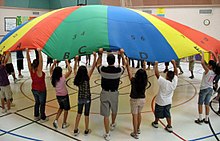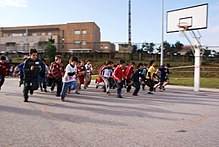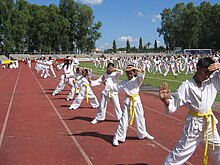Physical education


Physical education, often abbreviated to Phy Ed. or PE, and sometimes informally referred to as gym class or simply just gym, is a subject taught in schools around the world. PE is taught during primary and secondary education and encourages psychomotor, cognitive, and effective learning through physical activity and movement exploration to promote health and physical fitness.[1] When taught correctly and in a positive manner, children and teens can receive a storm of health benefits. These include reduced metabolic disease risk, improved cardiorespiratory fitness, and better mental health.[2] In addition, PE classes can produce positive effects on students' behavior and academic performance.[3] Research has shown that there is a positive correlation between brain development and exercising.[4] Researchers in 2007 found a profound gain in English Arts standardized test scores among students who had 56 hours of physical education in a year, compared to those who had 28 hours of physical education a year.[5]
Many physical education programs also include health education as part of the curriculum. Health education is the teaching of information on the prevention, control, and treatment of diseases.[6]
Curriculum in Physical Education[edit]
A highly effective physical education program aims to develop physical literacy through the acquisition of skills, knowledge, physical fitness, and confidence.[7] Physical education curricula promote healthy development of children, encourage interest in physical activity and sport, improve learning of health and physical education concepts, and accommodate for differences in student populations to ensure that every child receives health benefits.[8] These core principles are implemented through sport participation, sports skill development, knowledge of physical fitness and health, as well as mental health and social adaptation.[8]
Physical education curriculum at the secondary level includes a variety of team and individual sports, as well as leisure activities. Some examples of physical activities include basketball, soccer, volleyball, track and field, badminton, tennis, walking, cycling, and swimming.[9] Chess is another activity that is included in the PE curriculum in some parts of the world. Chess helps students to develop their cognitive thinking skills and improves focus, while also teaching about sportsmanship and fair play.[9] Gymnastics and wrestling activities offer additional opportunities for students to improve the different areas of physical fitness including flexibility, strength, aerobic endurance, balance, and coordination.[9] Additional activities in PE include football, netball, hockey, rounders, cricket, four square, racing, and numerous other children's games. Physical education also teaches nutrition, healthy habits, and individuality of needs.[10]
Pedagogy[edit]

The main goals in teaching modern physical education are:[11]
- To expose children and teens to a wide variety of exercise and healthy activities. Because P.E. can be accessible to nearly all children, it is one of the only opportunities that can guarantee beneficial and healthy activity in children.
- To teach skills to maintain a lifetime of fitness as well as health.
- To encourage self-reporting and monitoring of exercise.
- To individualize duration, intensity, and type of activity.
- To focus feedback on the work, rather than the result.
- To provide active role models.
It is critical for physical educators to foster and strengthen developing motor skills and to provide children and teens with a basic skill set that builds their movement repertoire, which allows students to engage in various forms of games, sports, and other physical activities throughout their lifetime.[12]
These goals can be achieved in a variety of ways. National, state, and local guidelines often dictate which standards must be taught in regards to physical education. These standards determine what content is covered, the qualifications educators must meet, and the textbooks and materials which must be used. These various standards include teaching sports education, or the use of sports as exercise; fitness education, relating to overall health and fitness; and movement education, which deals with movement in a non-sport context.[12]
These approaches and curricula are based on pioneers in PE, namely, Francois Delsarte, Liselott Diem, and Rudolf von Laban, who, in the 1800s focused on using a child's ability to use their body for self-expression. This, in combination with approaches in the 1960s, (which featured the use of the body, spatial awareness, effort, and relationships) gave birth to the modern teaching of physical education.[13]
Recent research has also explored the role of physical education for moral development in support of social inclusion and social justice agendas,[14] where it is under-researched, especially in the context of disability, and the social inclusion of disabled people.[15]
Technology use in physical education[edit]
Many physical education classes utilize technology to assist their pupils in effective exercise. One of the most affordable and popular tools is a simple video recorder. With this, students record themselves, and, upon playback, can see mistakes they are making in activities like throwing or swinging.[16] Studies show that students find this more effective than having someone try to explain what they are doing wrong, and then trying to correct it.[16]
Educators may also use technology such as pedometers and heart rate monitors to make step and heart rate goals for students.[17][18][19] Implementing pedometers in physical education can improve physical activity participation, motivation and enjoyment.[20]
Other technologies that can be used in a physical education setting include video projectors and GPS systems. Gaming systems and their associated games, such as the Kinect, Wii, and Wii Fit can also be used. Projectors are used to show students proper form or how to play certain games. GPS systems can be used to get students active in an outdoor setting, and active exergames[clarification needed] can be used by teachers to show students a good way to stay fit in and out of a classroom setting.[21] Exergames, or digital games that require the use of physical movement to participate, can be used as a tool to encourage physical activity and health in young children.[22]
Technology integration can increase student motivation and engagement in the Physical Education setting.[23] However, the ability of educators to effectively use technology in the classroom is reliant on a teacher's perceived competence in their ability to integrate technology into the curriculum.[23]
Beyond traditional tools, recent AI advancements are introducing new methods for personalizing physical education, especially for adolescents. AI applications like adaptive coaching are starting to show promise in enhancing student motivation and program effectiveness in physical education settings.[24]
By location[edit]
According to the World Health Organization (WHO), it is suggested that young children should be participating in 60-minutes of exercise per day at least 3 times per week in order to maintain a healthy body.[25] This 60-minute recommendation can be achieved by completing different forms of physical activity, including participation in physical education programs at school.[26] A majority of children around the world participate in Physical Education programs in general education settings.[27] According to data collected from a worldwide survey, 79% of countries require legal implementation of PE in school programming.[27] Physical education programming can vary all over the world.
Asia[edit]
Philippines[edit]
In the Philippines, P.E. is mandatory for all years in school, unless the school gives the option for a student to do the Leaving Certificate Vocational Programme instead for their fifth and sixth year. Some schools have integrated martial arts training into their physical education curriculum.[28][29][30][31][32]
Singapore[edit]
A Biennial compulsory fitness exam, NAPFA, is conducted in every school to assess pupils' physical fitness in Singapore.[33] This includes a series of fitness tests. Students are graded by a system of gold, silver, bronze, or as a fail. NAPFA for pre-enlistees serves as an indicator for an additional two months in the country's compulsory national service training if they attain bronze or fail.
Europe[edit]

Ireland[edit]
In Ireland, one is expected to do two semesters worth of 80-minute PE classes. This also includes showering and changing times. So, on average, classes are composed of 60–65 minutes of activity.[34]
Poland[edit]
In Poland, pupils are expected to do at least three hours of PE a week during primary and secondary education.[35] Universities must also organise at least 60 hours of physical education classes in undergraduate courses.[36][clarification needed]
Sweden[edit]
In Sweden, the time school students spend in P.E. lessons per week varies between municipalities, but generally, years 0 to 2 have 55 minutes of PE a week; years 3 to 6 have 110 minutes a week, and years 7 to 9 have 220 minutes. In upper secondary school, all national programs have an obligatory course, containing 100 points of PE, which corresponds to 90–100 hours of PE during the course (one point per hour). Schools can regulate these hours as they like[how?] during the three years of school students attend. Most schools have students take part in this course during the first year and offer a follow-up course, which also contains 100 points/hours.[37]
United Kingdom[edit]
This section needs expansion. You can help by adding to it. (December 2021) |
In England, pupils in years 7, 8, and 9 are expected to do two hours of exercise per week. Pupils in years 10 and 11 are expected to do one hour of exercise per week.[38]
In Wales, pupils are expected to do two hours of PE a week.[39]
North America[edit]
Canada[edit]
In British Columbia, the government has mandated in the grade one curriculum that students must participate in physical activity daily five times a week. The educator is also responsible for planning Daily Physical Activity (DPA), which is thirty minutes of mild to moderate physical activity a day (not including curriculum physical education classes). The curriculum also requires students in grade one to be knowledgeable about healthy living. For example, they must be able to describe the benefits of regular exercise, identify healthy choices in activities, and describe the importance of choosing healthy food.[40][better source needed]
Ontario, Canada has a similar procedure in place. On October 6, 2005, the Ontario Ministry of Education (OME) implemented a DPA policy in elementary schools, for those in grades 1 through 8. The government also requires that all students in grades 1 through 8, including those with special needs, be provided with opportunities to participate in a minimum of twenty minutes of sustained, moderate to vigorous physical activity each school day during instructional time.[41]
United States[edit]
The 2012 "Shape Of The Nation Report" by the National Association for Sport and Physical Education (part of SHAPE America) and the American Heart Association found that while nearly 75% of states require physical education in elementary through high school, over half of the states permit students to substitute other activities for their required physical education credit, or otherwise fail to mandate a specific amount of instructional time. According to the report, only six states (Illinois, Hawaii, Massachusetts, Mississippi, New York, and Vermont) require physical education at every grade level.[42] A majority of states[quantify] in 2016 did not require a specific amount of instructional time, and more than half allow exemptions or substitution. These loopholes can lead to reduced effectiveness of the physical education programs.[43]
Zero Hour is a before-school physical education class first implemented by Naperville Central High School. In the state of Illinois, this program is known as Learning Readiness P.E. (LRPE). The program was based on research indicating that students who are physically fit are more academically alert, experience growth in brain cells, and enhancement in brain development. NCHS pairs a P.E. class that incorporates cardiovascular exercise, core strength training, cross-lateral movements, as well as literacy and math strategies which enhance learning and improve achievement.[44]
See also[edit]
References[edit]
- ^ Sun, Haichun; Li, Weidong; Shen, Bo (July 2017). "Learning in Physical Education: A Self-Determination Theory Perspective". Journal of Teaching in Physical Education. 36 (3): 277–291. doi:10.1123/jtpe.2017-0067. ISSN 0273-5024.
- ^ Hollis, J.L.; Sutherland, R.; Williams, A.J.; et al. (April 24, 2017). "A systematic review and meta-analysis of moderate-to-vigorous physical activity levels in secondary school physical education lessons". International Journal of Behavioral Nutrition and Physical Activity. 14 (1). BMC: 52. doi:10.1186/s12966-017-0504-0. PMC 5402678. PMID 28438171.
- ^ Wong, Alia (2019-01-29). "Gym Class Is So Bad Kids Are Skipping School to Avoid It". The Atlantic. Retrieved 2019-01-30.
- ^ Reynolds, Gretchen (15 September 2010). "Phys Ed: Can Exercise Make Kids Smarter?". The New York Times. Retrieved 18 April 2013.
- ^ Tremarche, Pamela V.; Robinson, Ellyn M.; Graham, Louise B. (2007). "Physical Education and Its Effect on Elementary Testing Results". Physical Educator. 64 (2): 58–64.
- ^ Ruiz-Ramírez, Jessica Alejandra; Olarte-Arias, Yury Arenis; Glasserman-Morales, Leonardo David (2021-06-15). "Educational Processes for Health and Disease Self-Management in Public Health: A Systematic Review". International Journal of Environmental Research and Public Health. 18 (12): 6448. doi:10.3390/ijerph18126448. ISSN 1660-4601. PMC 8296271. PMID 34203594.
- ^ SHAPE America. (2013). Grade-level outcomes for K-12 physical education. Reston, VA: Author
- ^ a b Meng, Xuan; Horrell, Andrew; McMillan, Paul; Chai, Guorong (2020-12-20). "'Health First' and curriculum reform in China: The experiences of physical education teachers in one city". European Physical Education Review. 27 (3): 595–612. doi:10.1177/1356336x20977886. hdl:20.500.11820/28a578b9-0292-4e53-ac18-0828d0b6a4a8. ISSN 1356-336X. S2CID 234554327.
- ^ a b c Ruzmatovich, U. S., & Shohbozjon G‘ayratjon o‘g, Q. (2023). Uzbekistan's General Education School Physical Education Programme: A Curriculum Analysis. Best Journal of Innovation in Science, Research and Development, 2(5), 184-193.
- ^ Mitchell, Stephen (2016). The Essential of Teaching Physical Education. Shape America - Society of Health and Physical Educators. pp. 1 page cited (4 page). ISBN 978-1-4925-0916-5.
- ^ Paula Keyes Kun (December 30, 2003). "Children Need Greater Amount of Physical Activity in 2004" (PDF). National Association for Sport and Physical Education. Retrieved December 29, 2021.
- ^ a b Approaches to Physical Education in Schools. NCBI. 30 October 2013. Retrieved December 29, 2021.
- ^ Weiller Abels, Karen; Bridges, Jennifer (March 8, 2010). Teaching movement education : foundations for active lifestyles. Human Kinetics. ISBN 978-0736074568. OCLC 880580108.
- ^ Rossi, Tony; Jeanes, Ruth (2016-05-18). "Education, pedagogy and sport for development: addressing seldom asked questions". Sport, Education and Society. 21 (4): 483–494. doi:10.1080/13573322.2016.1160373. ISSN 1357-3322.
- ^ Sandford, Rachel; Beckett, Angharad; Giulianotti, Richard (2022-02-12). "Sport, disability and (inclusive) education: critical insights and understandings from the Playdagogy programme". Sport, Education and Society. 27 (2): 150–166. doi:10.1080/13573322.2021.1902299. ISSN 1357-3322. S2CID 236342803. Archived from the original on 26 May 2021.
- ^ a b Wang, Lin; Myers, Deborah L.; Yanes, Martha J. (2010). "Creating Student-Centered Learning Experience through the Assistance of High-End Technology in Physical Education: A Case Study". Journal of Instructional Psychology. 37 (4): 352–356. ProQuest 853876818.
- ^ Woods, Marianne L.; Karp, Grace Goc; Miao, Hui; Perlman, Dana (26 April 2008). "PHYSICAL EDUCATORS' TECHNOLOGY COMPETENCIES AND USAGE". The Physical Educator. 65 (2). ProQuest 232994591.
- ^ "Using pedometers to assess physical activity participation levels". Humankinetics.com. 2010-04-01. Retrieved 2015-08-13.
- ^ "PEC: Pedometer Lesson Activities". Pecentral.org. Retrieved 2015-08-13.
- ^ Gu, Xiangli; Chen, Yu-Lin; Jackson, Allen W.; Zhang, Tao (2017-06-23). "Impact of a pedometer-based goal-setting intervention on children's motivation, motor competence, and physical activity in physical education". Physical Education and Sport Pedagogy. 23 (1): 54–65. doi:10.1080/17408989.2017.1341475. ISSN 1740-8989. S2CID 148626271.
- ^ Grimes, G. (2011, November 21). Interview by M Massey [Personal Interview]
- ^ Benzing, Valentin; Schmidt, Mirko (2018-11-08). "Exergaming for Children and Adolescents: Strengths, Weaknesses, Opportunities and Threats". Journal of Clinical Medicine. 7 (11): 422. doi:10.3390/jcm7110422. ISSN 2077-0383. PMC 6262613. PMID 30413016.
- ^ a b Wallace, Jason; Scanlon, Dylan; Calderón, Antonio (2022-08-02). "Digital technology and teacher digital competency in physical education: a holistic view of teacher and student perspectives". Curriculum Studies in Health and Physical Education. 14 (3): 271–287. doi:10.1080/25742981.2022.2106881. ISSN 2574-2981. S2CID 252177343.
- ^ Rowe, Jonathan P.; Lester, James C. (August 2020). "Artificial Intelligence for Personalized Preventive Adolescent Healthcare". Journal of Adolescent Health. 67 (2): S52–S58. doi:10.1016/j.jadohealth.2020.02.021. ISSN 1054-139X. PMID 32718516. S2CID 220840948.
- ^ "WHO | Physical activity and young people". Archived from the original on 2020-09-08. Retrieved 2022-03-02.
- ^ "WHO | Physical activity and young people". Archived from the original on 2020-09-08. Retrieved 2022-03-02.
- ^ a b Hardman, Ken (2008-01-01). "The Situation of Physical Education in Schools: A European Perspective". Human Movement. 9 (1). doi:10.2478/v10038-008-0001-z. ISSN 1899-1955.
- ^ Ndia Buenafe. "Jack & Jill School rules : Nopsscea karatedo events". Archived from the original on 2008-09-30. Retrieved 2 March 2022.
- ^ "Is Arnis De Mano Dead in the Philippines?". Archived from the original on 2007-05-23. Retrieved 2 March 2022.
- ^ "Regional Commissions and Chapters International Modern Arnis Federation Philippines Mindanao Commission". Imafp.com. Retrieved 2010-11-07.
- ^ "We learn from our children". Archived from the original on 2009-01-15. Retrieved 2 March 2022.
- ^ "Sunday Inquirer Magazine: Life Lessons from Karate". Showbizandstyle.inquirer.net. 2008-12-14. Archived from the original on 2012-03-04. Retrieved 2010-11-07.
- ^ "Napfa: From fitness test to education tool". Asiaone.com. Retrieved 2018-10-19.
- ^ "Physical Education Curriculum" (PDF). Curriculumonline.ie. Retrieved 2 March 2022.
- ^ "Dz.U. 2002 nr 15 poz. 142. Rozporządzenie Ministra Edukacji Narodowej i Sportu z dnia 12 lutego 2002 r. w sprawie ramowych planów nauczania w szkołach publicznych". Internetowy System Aktów Prawnych. Retrieved 31 October 2010.
- ^ "Standardy kształcenia dla poszczególnych kierunków studiów i poziomów kształcenia". Biuletyn Informacj Publicznej. Archived from the original on 20 November 2010. Retrieved 31 October 2010.
- ^ "Physical Education and Health" (PDF). Skolverket. Retrieved April 15, 2019.
- ^ "National curriculum in England: physical education programmes of study". Gov.uk. Retrieved 24 November 2016.
- ^ "PE Provision in Secondary Schools" (PDF). Sport Council Wales. 2007-01-01. Archived from the original (PDF) on 2016-08-20. Retrieved 2024-01-16.
- ^ BC curriculum package
- ^ "Daily Physical Activity in Schools 2005 : RESOURCE GUIDE : Grades 1 to 3" (PDF). Archived from the original (PDF) on 2006-12-12. Retrieved 2 March 2022.
- ^ "Majority of States Have Loopholes That Let Kids Get Out of Gym Class". HuffPost. 2012-11-14.
- ^ "Shape of the Nation : Physical Education in the USA" (PDF). Shapeamerica.org. Retrieved 2 March 2022.
- ^ "Enhancing P.E. in Illinois" (PDF). Iphioline.org. Retrieved 2 March 2022.
External links[edit]
- . Encyclopedia Americana. 1920.


